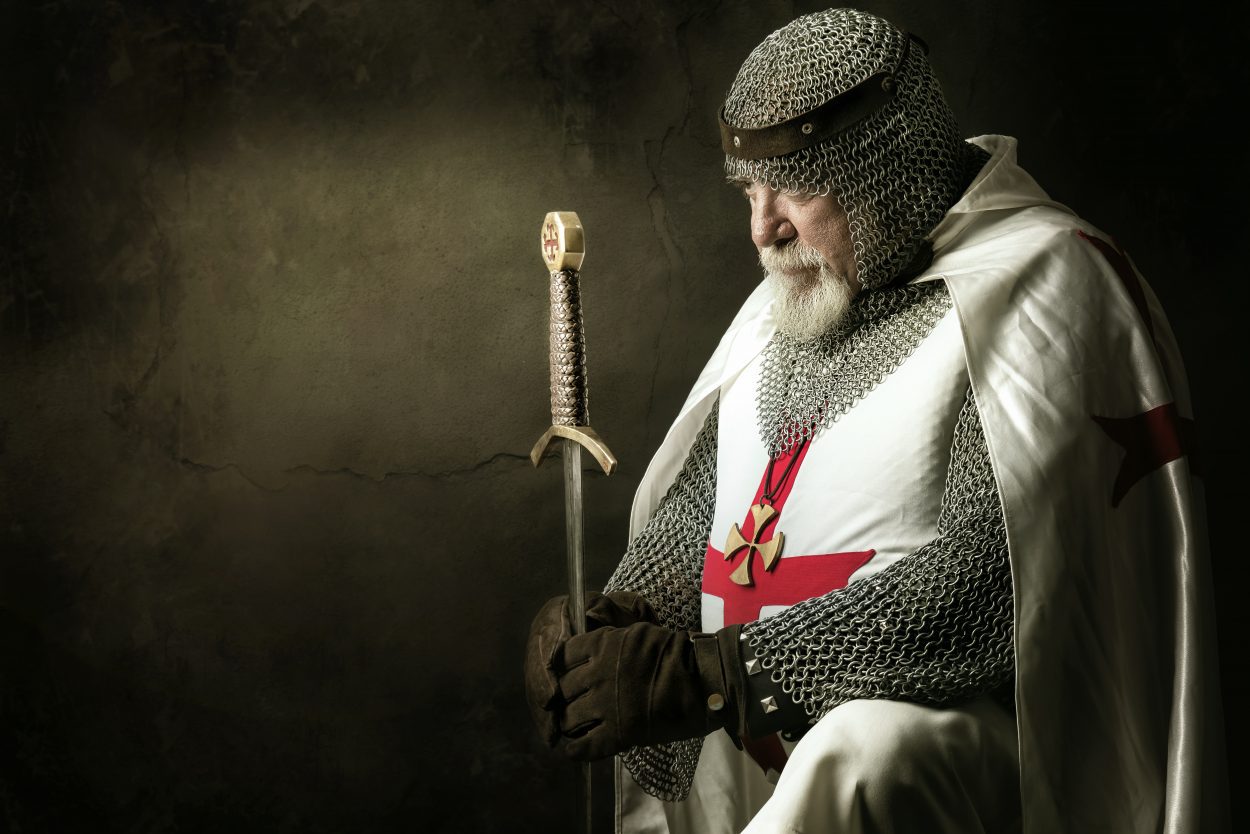The Knights Templar, also known as the Poor Fellow-Soldiers of Christ and of the Temple of Solomon, or the Order of Solomon’s Temple, was a religious military order of knighthood who served the Catholic church.
Following the successes of the 1st Crusade, a number of Crusader states were formed in the Holy Land, leading to an influx of pilgrims from Western Europe to travel to the sacred sites of Christendom.
Many pilgrims were either killed by banditry, or whilst crossing through hostile Muslim controlled territory. This led to the founding of a military order called the Poor Knights of the Temple of King Solomon in 1118 by Hugues de Payens, along with relatives and brothers in arms, with the sole purpose of protecting travellers on their pilgrimage.
The Knights Templar swore an oath of poverty, chastity, obedience, and were expected to honour the fasts and vigils of the monastic calendar just as the Cistercians and other monks.

With the support of patronage by Baldwin II, King of Jerusalem, the Knights were headquartered on Temple Mount, establishing a large economic infrastructure described as the first multinational corporation, that spread across all the kingdoms of Europe and the Holy Land.
By the 12th century, the strength of Christian rule in the Holy Land was diluted, in part by dissension among Christian factions and internecine feuds, and by the partial unification of the Islamic world with effective leaders such as Saladin annexing Christian territories.
The loss of Jerusalem and key strongholds to the Ayyubid dynasty forced the Templars to relocate to outlining city strongholds such as Acre, Tortosa, and Atlit, but these too fell in the 13th century, resulting in their headquarters moving to Limassol on the island of Cyprus.
A garrison was maintained at the fortress of Ruad on the small island of Arwad, but at the start of the 14th century this was lost to the Egyptian Mamluk Sultanate, marking the fall of the last crusader outpost in the Holy Land.
Without a mission, the influence and support for the templars dwindled, but they still maintained a strong economic powerbase through their network of Templar houses and holdings spread across Europe. The order was not subject to local government, making it essentially a “state within a state”.
The situation caused heightened tensions with European nobility, especially since the Templars maintained a standing army that could pass freely without borders, making it one of the largest independent military organisations across Europe, answerable only to the Pope.
In 1305, Pope Clement V was intent on merging the Templars with the Knights Hospitaller, and sent for the Templar Grand Master Jacques De Molay, and the Hospitaller Grand Master Fulk de Villaret.
Whilst waiting for the arrival of Villaret, De Molay and the Pope discussed several malicious charges made against the order by an ousted Templar, that had become gossip in the court of King Philip IV of France.
The Pope asked for the king’s support in an investigation, but Philip seized upon the rumours for his own purpose (possibly due to debts Philip owed the order from his war with England, or he feared the power and wealth the order had accumulated, and had been motivated by his own piety to destroy what he perceived as a heretical group).
On Friday 13th, 1307, Philip ordered the arrest of De Molay and the Templars in the Paris Temple, with the warrants stating “God is not pleased. We have enemies of the faith in the kingdom”.
Building on the rumours, further claims were made against the order involving the admission ceremonies, that they forced recruits to deny Christ and spit on the cross, as well as engage in indecent kissing, whilst the wider order was charged with homosexual practices, financial corruption, fraud, and the crime of idolatry by worshipping false idols.
Historians believe that Philip’s intent was to stoke contemporary fears of heretics, witches, and demons, similar to allegations Philip had used against Pope Boniface VIII to ruin his reputation amongst Europe’s rulers.
Many of the accused confessed to the charges under torture, and their confessions, even though obtained under duress, resulted in Pope Clement to issue the papal bull ‘Pastoralis praeeminentiae’, instructing all Christian monarchs in Europe to arrest the Templars and seize their holdings. De Molay protested and repudiated his confession, but was burned at the stake on the Ile des Javiaux in the Seine, along with other Templars across Europe who refused to confess.

The Pope called for further papal hearings to investigate the Templars’ guilt or innocence, but Philip superseded and threatened military action against the church unless the Pope agreed to disband the Templars.
At the Council of Vienne in 1312, the Pope issued a series of papal bulls, including ‘Vox in excelso’, which officially dissolved the order, and ‘Ad providam’, which turned over most of the Templar assets to the Knights Hospitallers. The remaining Templars were arrested and tried (but mostly without conviction), and were absorbed into other military orders, or were pensioned off for a peaceful monastic life.
In Portugal, the order was reconstituted as the Order of Christ in 1319 after King Dinis I refused to support the Templar cleansing (largely for the aid given by the order during the Reconquista and in the reconstruction of Portugal after the wars). The order was secularised in 1789 by Queen Maria I, which today exists as the Military Order of Christ.
Header Image Credit : Shutterstock





